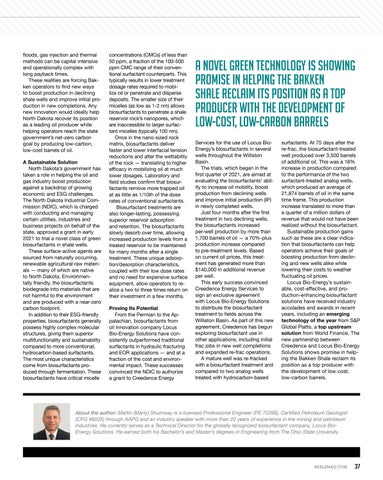floods, gas injection and thermal methods can be capital intensive and operationally complex with long payback times. These realities are forcing Bakken operators to find new ways to boost production in declining shale wells and improve initial production in new completions. Any new innovation would ideally help North Dakota recover its position as a leading oil producer while helping operators reach the state government’s net-zero carbon goal by producing low-carbon, low-cost barrels of oil. A Sustainable Solution North Dakota’s government has taken a role in helping the oil and gas industry boost production against a backdrop of growing economic and ESG challenges. The North Dakota Industrial Commission (NDIC), which is charged with conducting and managing certain utilities, industries and business projects on behalf of the state, approved a grant in early 2021 to trial a novel class of green biosurfactants in shale wells. These surface-active agents are sourced from naturally occurring, renewable agricultural raw materials — many of which are native to North Dakota. Environmentally friendly, the biosurfactants biodegrade into materials that are not harmful to the environment and are produced with a near-zero carbon footprint. In addition to their ESG-friendly properties, biosurfactants generally possess highly complex molecular structures, giving them superior multifunctionality and sustainability compared to more conventional, hydrocarbon-based surfactants. The most unique characteristics come from biosurfactants produced through fermentation. These biosurfactants have critical micelle
concentrations (CMCs) of less than 50 ppm, a fraction of the 100-500 ppm CMC range of their conventional surfactant counterparts. This typically results in lower treatment dosage rates required to mobilize oil or penetrate and disperse deposits. The smaller size of their micelles (as low as 1-2 nm) allows biosurfactants to penetrate a shale reservoir rock’s nanopores, which are inaccessible to larger surfactant micelles (typically 100 nm). Once in the nano-sized rock matrix, biosurfactants deliver faster and lower interfacial tension reductions and alter the wettability of the rock — translating to higher efficacy in mobilizing oil at much lower dosages. Laboratory and field studies confirm that biosurfactants remove more trapped oil at as little as 1/10th of the dose rates of conventional surfactants. Biosurfactant treatments are also longer-lasting, possessing superior reservoir adsorption and retention. The biosurfactants slowly desorb over time, allowing increased production levels from a treated reservoir to be maintained for many months after a single treatment. These unique adsorption/desorption characteristics, coupled with their low dose rates and no need for expensive surface equipment, allow operators to realize a two to three times return on their investment in a few months. Proving Its Potential From the Permian to the Appalachian, biosurfactants from oil innovation company Locus Bio-Energy Solutions have consistently outperformed traditional surfactants in hydraulic fracturing and EOR applications — and at a fraction of the cost and environmental impact. These successes convinced the NDIC to authorize a grant to Creedence Energy
A novel green technology is showing promise in helping the Bakken Shale reclaim its position as a top producer with the development of low-cost, low-carbon barrels Services for the use of Locus BioEnergy’s biosurfactants in several wells throughout the Williston Basin. The trials, which began in the first quarter of 2021, are aimed at evaluating the biosurfactants’ ability to increase oil mobility, boost production from declining wells and improve initial production (IP) in newly completed wells. Just four months after the first treatment in two declining wells, the biosurfactants increased per-well production by more than 1,700 barrels of oil — a 70%-plus production increase compared to pre-treatment levels. Based on current oil prices, this treatment has generated more than $140,000 in additional revenue per well. This early success convinced Creedence Energy Services to sign an exclusive agreement with Locus Bio-Energy Solutions to distribute the biosurfactant treatment to fields across the Williston Basin. As part of this new agreement, Creedence has begun exploring biosurfactant use in other applications, including initial frac jobs in new well completions and expanded re-frac operations. A mature well was re-fracked with a biosurfactant treatment and compared to two analog wells treated with hydrocarbon-based
surfactants. At 75 days after the re-frac, the biosurfactant-treated well produced over 3,500 barrels of additional oil. This was a 16% increase in production compared to the performance of the two surfactant-treated analog wells, which produced an average of 21,874 barrels of oil in the same time frame. This production increase translated to more than a quarter of a million dollars of revenue that would not have been realized without the biosurfactant. Sustainable production gains such as these are a clear indication that biosurfactants can help operators achieve their goals of boosting production from declining and new wells alike while lowering their costs to weather fluctuating oil prices. Locus Bio-Energy’s sustainable, cost-effective, and production-enhancing biosurfactant solutions have received industry accolades and awards in recent years, including an emerging technology of the year from S&P Global Platts, a top upstream solution from World Finance. The new partnership between Creedence and Locus Bio-Energy Solutions shows promise in helping the Bakken Shale reclaim its position as a top producer with the development of low-cost, low-carbon barrels.
About the author: Martin (Marty) Shumway is a licensed Professional Engineer (PE.72266), Certified Petroleum Geologist (CPG #6025) through AAPG and an industry speaker with more than 20 years of experience in the mining and petroleum industries. He currently serves as a Technical Director for the globally recognized biosurfactant company, Locus BioEnergy Solutions. He earned both his Bachelor’s and Master’s degrees in Engineering from The Ohio State University.
SHALEMAG.COM
37
